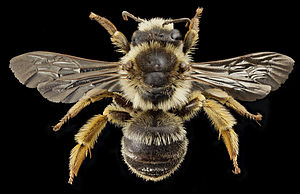Sawhorn bees
| Sawhorn bees | ||||||||||||
|---|---|---|---|---|---|---|---|---|---|---|---|---|

Bluebell sawhorn bee Melitta haemorrhoidalis |
||||||||||||
| Systematics | ||||||||||||
|
||||||||||||
| Scientific name | ||||||||||||
| Melitta | ||||||||||||
| Kirby , 1802 |
The sawhorn bees ( Melitta ) are a genus of bees from the Melittidae family with 47 known species.
distribution
The genus is distributed in the Palearctic , Nearctic and South and East Africa. Most species are found in the Palearctic. There are five centers of biodiversity: the Mediterranean (including Spain, Turkey and Maghreb), the Himalayas, China (mainly southern and northern areas), North America (California and east coast) and southern Africa.
features
Sawhorn bees are approx. 10 to 14 mm tall, dark in color, with light hair ties on the abdomen, which can be narrow or wide. In both sexes they can be confused with Andrena species, but they lack the hair lock ( flocculus ) typical of Andrena at the base of the hind leg ( trochanter ).
The antennae of the males have characteristic, sometimes difficult to recognize, thickenings. This "saw structure" is the reason for the German name.
Way of life
The biology is mainly known from the European species. In the sawhorn bees, the males hatch about three weeks before the females (proteransdrisch) in June and swarm on fixed trajectories between the foraging plants in search of females. The males often form sleeping communities on stems or in flowers.
The females live solitary, they dig nests in the ground, which can often be overgrown. Most species are oligoletic; H. they only collect pollen from certain plants.
Systematics
The genus is divided into two sub-genera. The subgenus Melitta (see str.) Contains 7 species, is restricted to the Palearctic and contains the species M. tricincta , M. leporina and M. nigricans occurring in Europe . The subgenus Cilissa contains the other 40 species and is distributed in the Palearctic, Nearctic and Afrotropic. The other Central European species belong to this subgenus (see below).
Central European species
After, each occurrence in Germany (D), Austria (A), Switzerland (CH), German names after.
- Esparsette sawhorn bee Melitta dimidiata (A, D, CH )
- Bluebell sawhorn bee Melitta haemorrhoidalis (A, D, CH)
- Alfalfa sawhorn bee Melitta leporina (A, D, CH)
- Melitta melanura (D)
- Purple loosestrife sawhorn bee Melitta nigricans (A, D, CH)
- Toothed sawhorn bee Melitta tricincta (A, D, CH)
literature
- Paul Westrich, 2018. Germany's wild bees. Eugen Ulmer Verlag, Stuttgart. 827 p. (Here p. 138ff, 566f); ISBN 978-3-8186-0123-2 .
- A. Müller, A. Krebs, F. Amiet 1997. Bees. Central European species, way of life, observation. Natur Buch Verl. ISBN 3-89440-241-5 .
Individual evidence
- ↑ a b D. & C. Michez Eardley: Monographic revision of the bee genus Melitta Kirby 1802 (Hymenoptera: Apoidea: Melittidae) . In: Ann. soc. entomol. Fr. (ns) . tape 43 , no. 4 , 2007, p. 379-440 ( atlashymenoptera.net [PDF]).
- ↑ a b c d D. Michez, M. Kuhlmann, SP Ivanov & VG Radchenko: Description of four new species in the bee genus Melitta Kirby, 1802 (Hymenoptera: Melittidae) . In: Zootaxa . tape 3337 , 2012, p. 57-67 ( atlashymenoptera.net [PDF]).
- ↑ a b c Müller, Andreas., Krebs, Albert., Amiet, Felix .: Bees: Central European genera, way of life, observation . Natur-Buch-Verl, Augsburg 1997, ISBN 3-89440-241-5 , p. 384 .
- ↑ Solitary bee species: Sawhorn bees (Melitta). Retrieved April 29, 2019 .
- ^ A b P. Westrich: The wild bees of Germany . 2018, p. 827 .